Table of contents
Do you know what Japamala is?
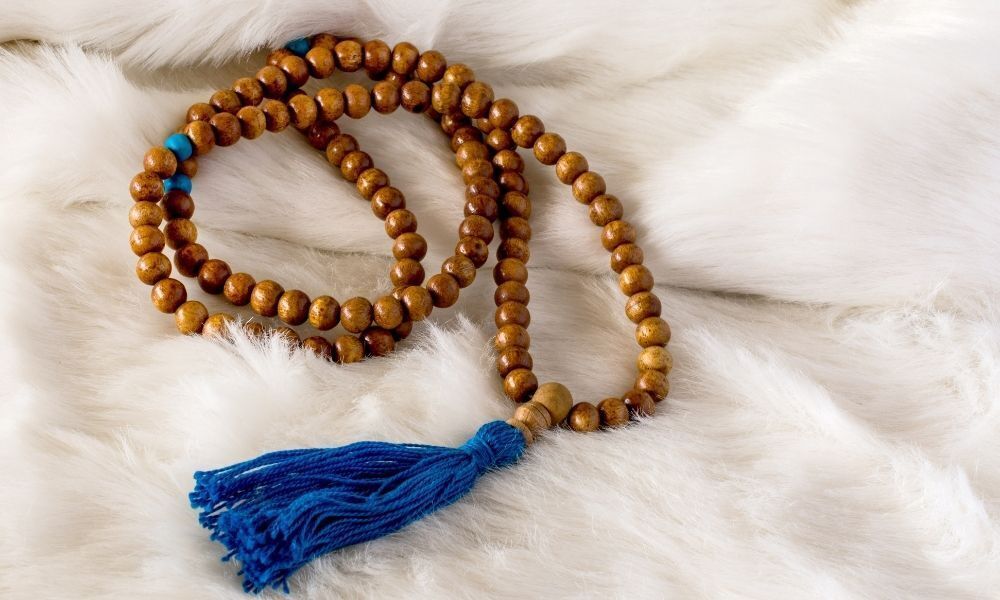
The japamala is an ancient devotional object consisting of a string of beads used in meditation practices to repeat and count mantras. It is also considered a protective talisman against negative energies and facilitates relaxation.
There are many benefits it can provide, one of them being to help in meditation practices to achieve full attention. In this article you will learn about the origins and history of the japamala, what are its benefits, and how to make and energize yours.
Getting to know the Japamala
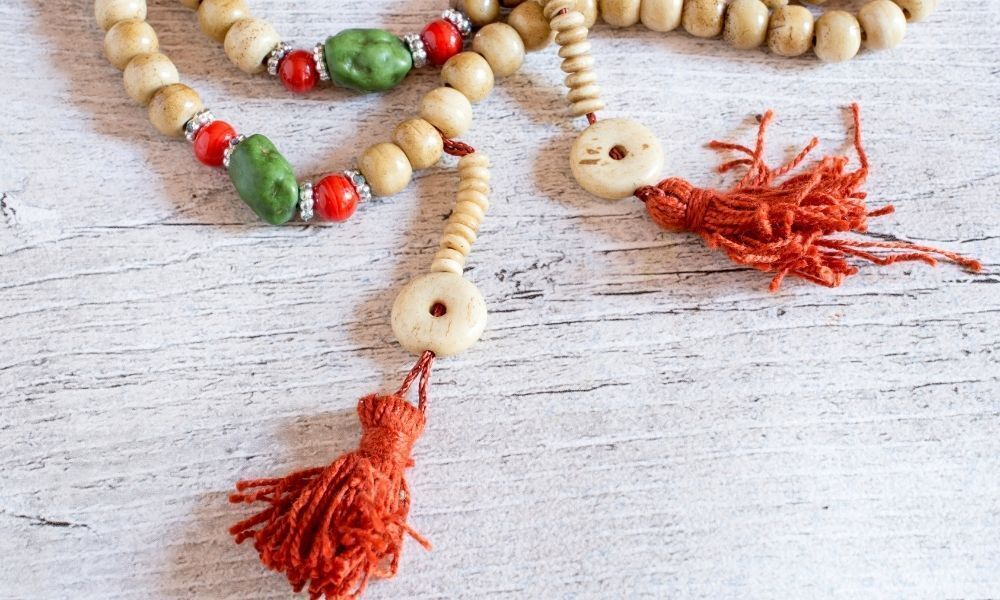
Two thirds of religions around the world use some kind of string of beads to chant mantras or prayers. It is believed that this habit arose in Hinduism and was later adopted by Buddhists, giving rise to the japamala. Here is a little history, what are the uses and how the japamala is made.
History and meaning
Japamala is a word derived from Sanskrit, in which "japa" means to whisper, murmur and "mala" means cord, necklace. Thus, in a literal translation one can say that japamala is a necklace for whispering, that is, for meditating, praying.
Historians have found records of the first beaded necklaces in Africa from 10,000 B.C. And in India the use of beads for prayer dates back to the 8th century B.C., one of the most distant in the world. The oldest necklaces found to date are from about 4,200 years ago.
Its origin in the format in which it is known today comes from the Hindu tradition of Yoga, which was later adopted by Buddhism for meditation practices and probably served as inspiration for the Western rosary of the Catholic strand of Christianity.
Religions that use the Japamala
Several are the religions that employ some type of beaded cord for their practices. Some of the best known beaded cords are:
- Masbahas or Misbahas, used in Islamic tradition possessing 99 or 33 beads;
- Japamala, used by Hindus and Buddhists, with 108 beads or their multiples;
- Rosary of the Sikh tradition, with 27 or 108 beads;
- Christian rosaries with 59 beads of the Catholics, 100 knots on the komboskini of the Orthodox or 33 beads of the Anglicans;
- Initiation rosary with 33 rosicrucian and masonic beads.
What are the uses of Japamala?
The japamala is used in different ways according to the spiritual practice in which it is employed. In Hinduism, it is used mainly in "Sadhana" or "Abhyasa", terms meaning spiritual practice, daily practice of Yoga, and is also widely used as a protective amulet.
For the Buddhist practice, the japamalas are used in different ways according to the ramifications of the religion, but in general, in meditations and repetitions of mantras. Its uses are not limited to these practices, because it is currently used in repetitions of prayers such as ho'oponopono, prayer originating in Hawaii, mentalizations and several others.
How is it done?
Nowadays, one can find japamalas made of the most diverse materials, but according to tradition they should be made with wooden beads, seeds or stones. In India the most popular ones are made of rudraksha seeds, also known as "Shiva's Tears", whose benefits are widespread among meditation practitioners.
It used to be very common for them to be made also with sandalwood beads, which is a naturally scented wood. However, with the exacerbated exploitation of this sacred tree, japamalas made with this material have become rare.
Various materials, always of natural origin, are used in the making of the japamalas, such as semi-precious stones, which carry their own energy. In Brazil, one can find japamalas made from acai seeds. The cord is necessarily made of cotton and finally, the Meru and the tassel.
What are the parts of a Japamala?
The japamala is formed by 108 beads or their multiples; the Meru - or "guru", which is the mark of the beginning or end of the repetitions, usually of another color or shape, should not be touched or counted and symbolizes the master who guides the practice. Finally, it is decorated with a tassel or tassel, an ornament made of fringes, sometimes colored.
Why does the Japamala have 108 beads?
Traditional japamalas have, in essence, 108 beads, as this is a very symbolic number for Yoga. Ancient sacred texts suggest that mantras must be repeated 108 times to reach the state of transcendence, a higher stage of consciousness in which the fixations of the mind are overcome.
In traditional Buddhist thought, people are believed to possess 108 afflictions or kleshas - mental states that disturb the mind and turn into harmful actions. Another reading explains that 108 is the number of possible dharmas.
Another possibility is that 108 is a number consecrated for mathematical, physical and metaphysical reasons, because it is a product of simple operations. It is possible to find references to this number for sun salutations during Yoga ritualistic practices. And in several Buddhist temples there are stairs with 108 steps and there are 108 yantras, diagrams used in meditation.
Other types of Japamala
There are also japamalas with 54 and 27 beads, and japamalas with 18 and 9 can also be found, although they are rarely used. However, during meditation practice, repetitions should always lead to 108, so in the case of a 54-bead japamala, two cycles should be completed, if it has 27 beads 4 cycles should be completed, and so on.
For Tibetan Buddhism, larger japamalas with 111 beads are often used. When counting, they calculate a cycle as 100 repetitions and 11 additional beads to compensate for errors.
In Japanese Buddhism, prayer beads are called "ojuzu" or "nenju", and come in different shapes, and can be longer and have threads at the ends. These beads can be rubbed during devotional practice, creating a noise that is considered purifying.
Double beaded necklaces, called nikka juzu, worn for reciting the Buddha's names, are also found. Among the different practices, some changes in shape may be noted, but among followers, the 108-beaded japamalas are generally the most widely used.
Benefits of Japamala
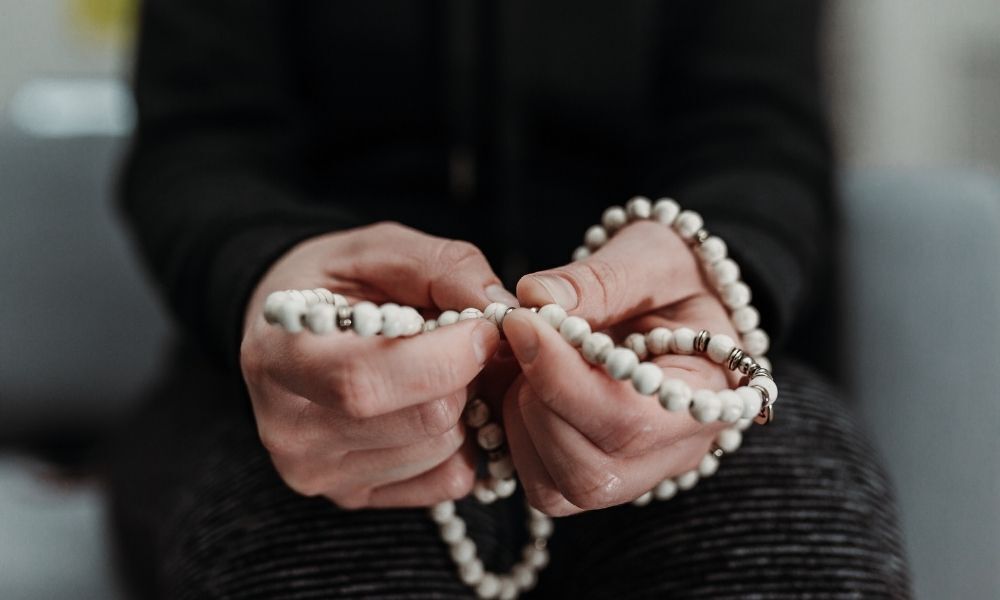
In various religions around the world, variations of the japamala are used to repeat prayers, mantras and breathing. This is a very useful tool for maintaining focus during a spiritual practice, but not only this benefit is obtained by the frequent use of the japamala. Understand what are some of its many benefits. See below!
Focus during meditation
For some people meditating can be tricky, as focusing completely becomes the first and most difficult obstacle. The japamala assists in establishing focus, as having something in hand can help turn attention back to the object.
Because of this, some japamalas are made with materials that aid in this meditative process, such as, for example, stones like amethyst or sandalwood. In addition, it is believed that they can accumulate good energy as it is used, recharging the person with each meditation.
Contact with prayer accounts
The materials used in the manufacture of the japamala usually have therapeutic benefits, which are activated by simply touching the beads. Also, as it is an object that absorbs the practitioner's good energies, handling or being in contact with the japamala activates the energy field of the person who touches it, ensuring protection and transmuting harmful energies.
When coming into contact with the japamala when practicing meditations and affirmations, the mind understands that it is the time to turn off and have one's attention focused on the spiritual, helping in deep meditation towards the transcendence of matter.
Assists in counting mantras
For Buddhists and Hindus, mantras must be repeated 108 times to achieve the state of full attention and transcendence. It would be a problem to keep worrying about counting while meditating, because the focus would be lost.
Therefore, the japamala is widely used for this purpose, as it lets you know how much has been repeated without requiring conscious mental counting.
Assists in healing and positive energies
The japamala itself is an energetically powerful spiritual tool, as it absorbs the energies of the mantras and the personal power of the practitioner. Because of this, its uses for healing, both physical, emotional and energetic, are many. Thus, repetitions of healing mantras with the japamala become even more powerful.
In the practice of Reiki, for example, it is not uncommon to see the therapist carrying the japamala for full attention, directing the energy and protecting his auric field. The patient can also receive Reiki with his japamala in hand, as it is an amulet that attracts and maintains the energies, which enhances the reception of the practice and keeps it longer in his body.
Determination in spiritual activities
The japamala when worn on the body of the practitioner, in addition to the benefits of protection and energization, serves as a constant reminder of the spiritual, because every time the stones touch the body, the subconscious mind turns its attention to this object, which in turn acts as a magnet for good energies and a barrier against bad ones.
Therefore, the japamala is often used by practitioners who seek discipline in their spirituality, because they are being recharged of this energy all the time, in every area of their lives.
Representativeness of personal objectives
Meditation with mantras when it is a daily practice has the power to activate healing, self-knowledge and confidence, as well as improve memory and concentration. It also reduces stress and anxiety, balances emotions and activates self-acceptance and self-empowerment. As a tool of this practice, the japamala carries all these benefits.
Among many advantages, the japamala helps the meditator to reach the most authentic stage of transcendence, representing the real personal and spiritual goals, banishing insecurities and other obstacles in order to prepare the person to achieve their goals.
Reward for a task
The use of the japamala for practices such as meditation, ho'oponopono, repetition of mentalizations and gratitude ensures a look at the world with the eyes of spirituality. It is well known that only a perspective of gratitude to life cultivates empathy and mental resilience, changing its vibrational pattern for good and love.
Of course, the focus of spirituality is not to do in order to receive something in return, but the opposite - sowing and reaping, or in the language of physics, action and reaction. When we energetically vibrate good energies, we attract the same.
Therefore, the simple act of cultivating your positive energy already attracts more and more of it into your life, in all aspects. Wearing the japamala, in addition to practicing meditation, to be protected from bad vibrations, generates a strong energetic field from which it is impossible for good energies to leave and bad ones to enter.
Making your Japamala
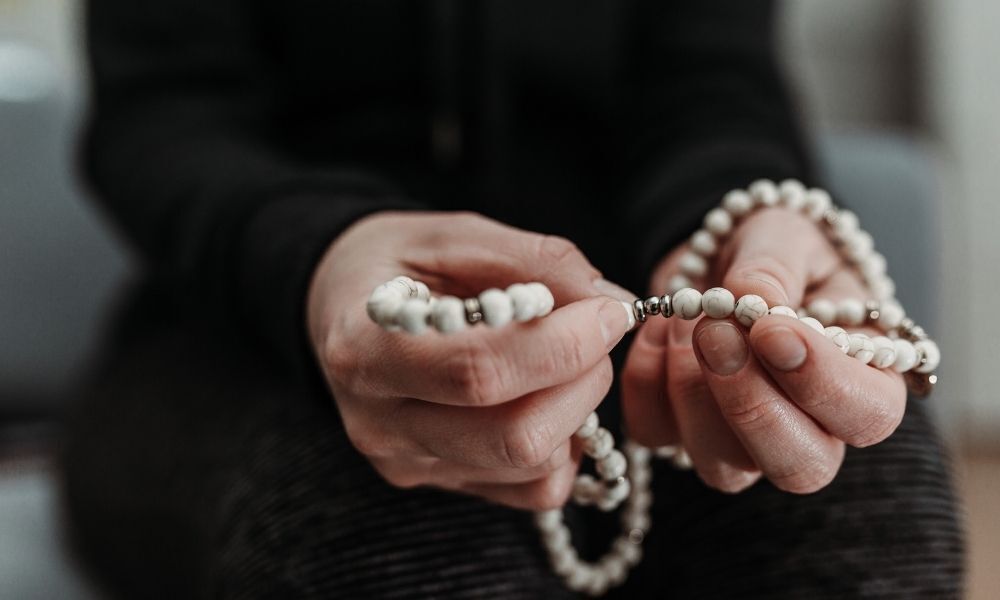
Much more than just a beaded necklace, the japamala is a symbol of spirituality and has the power to protect and channel people's energies. Therefore, when making your japamala, it is important to be aware that since it is an amulet, it cannot be made just any old way, but with the intention focused on the spiritual and good energies.
Learn what are the steps to make, energize and the correct way to use and store a japamala. See below!
How to do
The first step in making a japamala is choosing the right materials. Whether wooden beads, semi-precious stones or seeds, the choice needs, in addition to the aesthetic, to meet your intuition.
In the case of stones and crystals, the variety of benefits is extensive and the ideal is to look for those that correspond to the function of the japamala - meditation, protection and spirituality. The preferred ones for this purpose are: amethyst, tiger's eye, quartz, onyx, turquoise and blue in general.
Once the beads are chosen, whether 108, 54 or 27 - according to use and preference, the Meru should be chosen, which is usually a bead that stands out from the others, and can be larger or of another material. Also, the cord of the chosen size and the tassel of your favorite color.
Having the materials in hand, it is time to make it. Choose a quiet moment, without haste and that can be used exclusively for this. Because it is an object loaded with symbolism and energy, at the time of making it is very important to maintain positive energy, and a mantra can be repeated for each stone added to the cord.
How to energize your Japamala?
Before using a japamala for the first time, whether bought, gifted or made by the practitioner, it is necessary to energize and connect with it in order to "program" the amulet to the practitioner, aligning the individual's energies and intentions.
There are many ways to do this and none are universal, so find one that suits you and the japamala. It is important to observe the resistance of the material to water and sunlight, some stones do not resist humidity and heat, so the best way to energize the japamala is the one that will be safe to the material and that makes sense to the practitioner.
One of the most used methods is to immerse the japamala in water and some essential oil, leaving it soaking for 24 hours. In this way it will be purified physically and energetically. It can also be purified by smoking - placing it under the smoke of an incense or candle. It is essential to mentalize and focus the energy during the process.
It can also be left under a sun or moon bath, depending on what is desired and the material chosen. It can be placed in a window or a place that has total contact with the lunar or solar rays, intending that the energies can cleanse and energize your amulet. In the case of the moon, observe the cycle that can best benefit, as the full moon.
You can also channel your energy with your hands, such as Reiki for your japamala or even activate it with mantras. Nothing prevents more than one form being applied, as long as it helps to connect the energies.
How to use
After the energization, if you are not yet connected with your japamala, it is recommended to hold it with your dominant hand - the one you use for writing - or with both hands and visualize the energetic exchange, feeling the connection tightening. In this process it is common to feel as if a small pulse emanated from the object.
It is important to look for a quiet and peaceful place for your practice, and you can use candles, aromatherapy and incense. Preparing the place already puts your mind in the right vibration for meditation. Choose a comfortable position and a mantra or affirmation.
The left hand is used to handle the japamala and move the beads, and the right hand is used only to help hold it if necessary. Traditionally, the index finger is not used to touch the beads, as it symbolizes the ego, which should be left aside. Therefore, the middle finger and thumb can be used to move the beads.
You should start on the first bead after the Meru, which is not counted. Recite the mantra with each bead, and if you reach the end of the japamala and want to continue, you should go back from where you finished, without going over or counting the Meru. Concentrate on the breaths and the mantra, watching it act and echo in every corner of your being.
There are three types of japas - repetitions of mantras according to Mantra Yoga Samita, one of the main and most respected yoga publications. They are: Mãnasa, Upãmsu and Vãchika. Mãnasa japa cannot be heard, it is only done mentally. Upãmsu japa is only noticed by those who practice and Vãchika japa can be heard by those who practice and by everyone around.
How to store
The ideal is to keep the japamala in a sacred place, such as a specific altar, because it is more than just an object, it carries its energy and represents spirituality. But it is known that it is not always possible to have a place that is kept away from the gaze of the curious and that is specific for spirituality.
In such cases, a clean, organized and spiritually oriented place like a shelf or a space inside the closet, away from the energy of several people is enough. It can also be wrapped in a soft cloth to avoid scratching, in case it is made of stones. It should be kept as a treasure, because in time you will see that it really is.
If you prefer to wear it with you, it should be placed under your clothes, never exposed to the eyes and energies of others. It should not be worn as adornment or to expose spirituality, since the japamala should be used to find the divine and curb the ego, not to accentuate it.
Japamala is a great option to help with meditation!
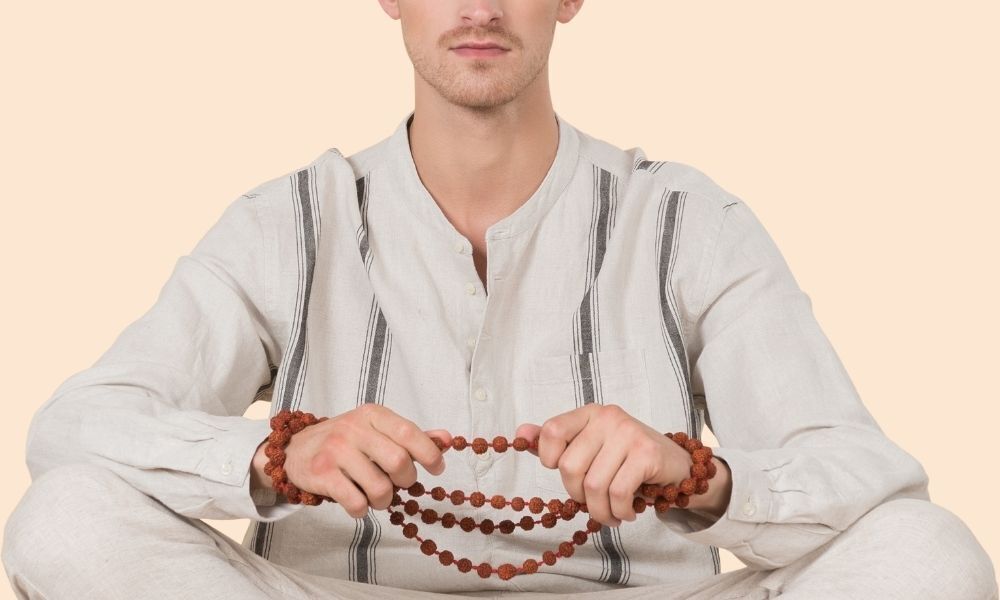
The japamala is a unique object, sacred and full of meaning. It is commonly used to maintain focus and assist in meditations and repetitions of mantras, mentalizations and affirmations. However, its various uses go far beyond this, as they are amulets of protection, absorbing good energies.
It is believed that as the japamala is used in spiritual practices, it conserves the practitioner's energies, acting as a vital energy magnet. Because of this, it is a very popular tool for healing and rebalancing emotions. And for these reasons, it is highly esteemed by those who seek spirituality in its purest and most transcendental form.

